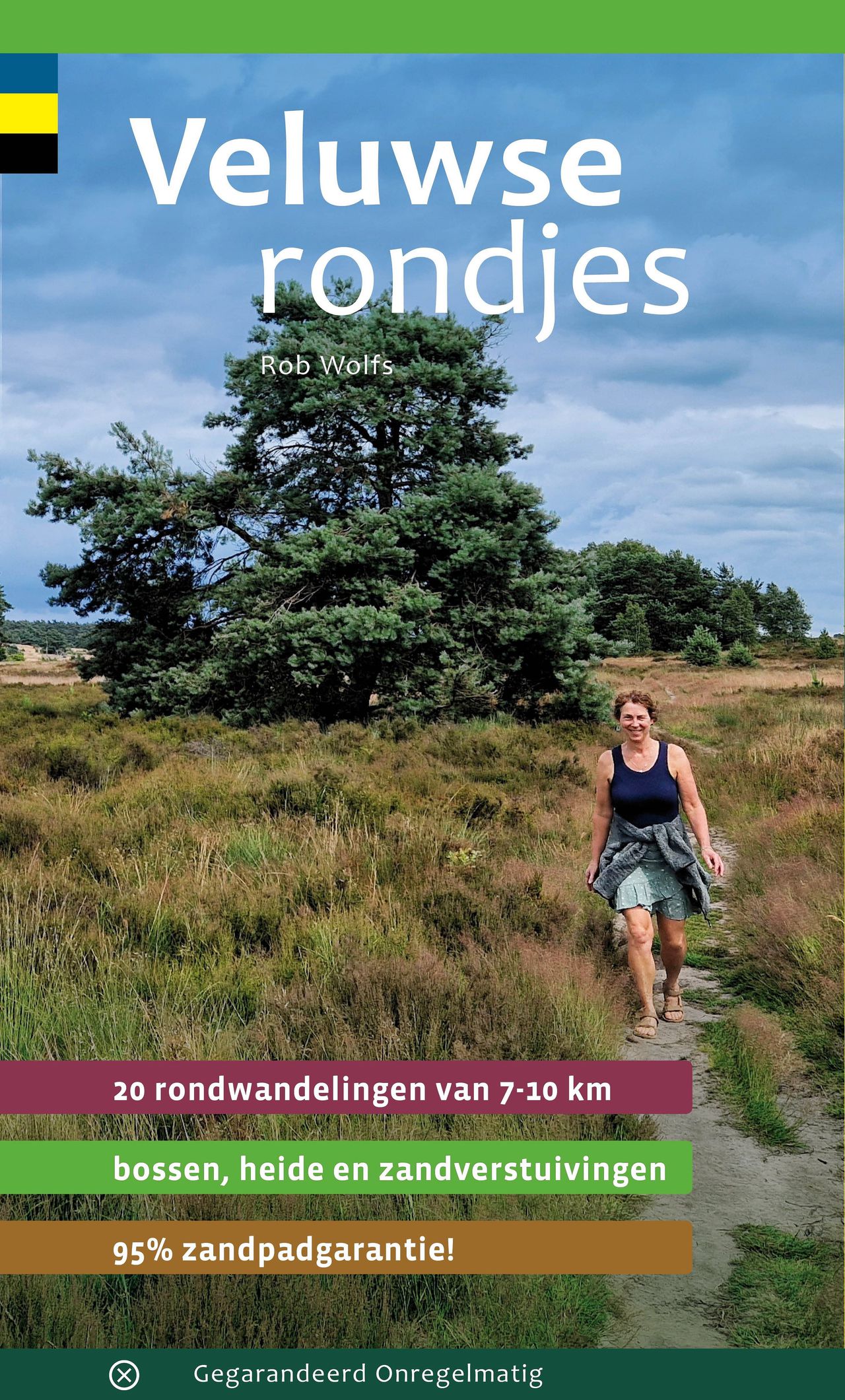Small laps, unknown cities and Dutch ‘mountains and deserts’: new walking guides

Small round on immense Veluwe
:format(webp)/s3/static.nrc.nl/wp-content/uploads/2025/03/26141551/web-2903ZAT-Tapuit-Sara-Noor-ten-Cate-lijn.png)
Rob Wolfs, star author of various walking books, saw the light a while ago. His walks in previous books were often quite long (20 kilometers was no exception), in his bundle published last year Walking around Arnhem and Nijmegen He ran in more manageable distances: between 7 and 10 kilometers. That clearly met a need. Very nice that Wolfs decided to copy this concept one on one to the Veluwe: this winter appeared Veluwe lapswith twenty circular walks, also between 7 and 10 kilometers.
The circles include almost all the pieces of Veluwe: Van Epe in the north to Rozendaal in the south, and carry both deep into the forests and along the edge with farmland, such as the western Gelderse Vallei.
We decide to take a look at Radio Kootwijk. The first direct radio contact with the Dutch East Indies was provided from this gigantic, concrete transmitted former broadcasting station (delivered in 1923). The main building, in Art Deco style, looks like a cathedral, and can be seen on the vast drifting sand plains from far away.
The 8 -kilometer route takes more or less around the special structures, but the circle is wide enough to see most of the walk only nature. The views are beautiful and we see a remarkable number of traces of wolves and boar on the sandy paths. For nature it is a blessing that this walk has not been running since last year between 15 March and 15 July, the breeding season. As a result, vulnerable birds such as the Boomleeuwerik, nightjar and Tapuit are rested to raise their nest with young.
These birds are on the cold February day that we are not yet running here in the Netherlands. But on the last part, when the concrete cathedral dominates the area again, we see the Klapekster, a special winter guest who prays prey on sharp branches and thorns. The walk can be perfectly combined with a visit to the Kröller-Müller Museum. But only from July 15.
How versatile the Veluwe is during the second walk in Hoog-Soeren, on the other side of the A1 (which cuts the Veluwe horizontally in half). There are gigantic beech forests around this village, making it a totally different walk. The route leads through dense forests where we hear black woodpeckers and along breathtaking views over plains where you could see wild with some luck (and binoculars). Just like the previous one, this 8 -kilometer route is described very clearly. When in doubt, there is also the GPS route on your phone that you can download.
At the end, in the transition area from forest to village, we are treated to an apple finch from a lush garden. During the coffee with apple pie in the brasserie at the end point we also see a yellow bunting in a tree. What a bird walhalla.
Between September 15 and December 25, this route cannot be walked: then Kroondomein Het Loo, through which this walk takes almost entirely, is closed so that the king can hunt here.
Unknown pieces of city
:format(webp)/s3/static.nrc.nl/wp-content/uploads/2025/03/26141549/web-2903ZAT-Geelgors-Sara-Noor-ten-Cate-lijn-1.png)
Recently appeared The compact city walk guide At the ANWB, a guide with 35 city walks, with tips for museums and lunch addresses. The nice thing is that the most famous cities of Rücksichtslos are skipped and that the walks conduct through less well -known Dutch towns and cities. Domburg, Ootmarsum, Coevorden, Bourtange – Whoever does not live in the area or has family has never been there.
We are going to take a look in Roermond, which we mainly knew because of the gigantic outlet that attracts hordes of day people. Indeed, after parking we see a large stream of people walking to the just outside the center of fashion paradise.
We focus on what this Midden-Limburg city (nearly 60,000 inhabitants) has to offer even more. We pass a beautiful city park, hidden behind old monastery walls, which, oddly enough, is not mentioned in the description but where you can sit. The walk goes further through the old center, where the Sint-Christoffelkathedral is showing off on the largest square in the city.
There is another church on another square: the Munsterkerk. The two characteristic towers were designed by Pierre Cuypers (1827-1921), who was born in Roermond and died. He designed many more buildings in the city and therefore has his own museum in Roermond. A statue of Cuypers, known to the general public from the Rijksmuseum and the Central Station in Amsterdam, is next to the Munsterkerk. He looks up in mind at his creation, his back turned to the miserable complex right behind him, where the V&D was and which has been vacant for eight years now. In the center we see a lot of beautiful and old, but it is a pity that a street is regularly marred by a more modern building, which means that that historic atmosphere is a bit lost.
Yet the city center of Roermond is definitely worth a visit, and here too you will find countless clothing stores – so don’t let that outlet be your main goal. Then you also miss the fine view of the river De Roer (branch of the Maas), from the Pauw terrace recommended by the book, one of the many catering establishments on the Roerkade.
At Assen in Drenthe, many people probably think the TT first. We read that Assen (70,000 inhabitants), unlike most provincial capitals, has no medieval urban past. Only in 1809 did it get city rights. Since then, the place has developed into a capital with villas and mansions – Assens Nickname is ‘Stad der Palaces’.
The walk shows that clearly: not a beautiful historic center, but those ‘palaces’ are impressive. Nice that the route leads through a surprising city park – we hear a green woodpecker laughing and are surprised that such a ‘forest’ is so close to the city center.
A piece of abroad
:format(webp)/s3/static.nrc.nl/wp-content/uploads/2025/03/26141546/web-2903ZAT-Appelvink-Sara-Noor-ten-Cate-lijn-1.png)
Every so often, Fontaine Uitgevers a bundle of walks appears previously in the nature magazine Roots were published. The books always have a theme, think of The most beautiful walks along water or The most beautiful bird & butterfly walks. Next week the newest will appear in the series: The most beautiful desert & mountain walks in the Netherlandswith seventeen routes that give you the idea of being in another country. That sounds like a great opportunity to walk into the hiking boots for the mountain holiday this summer, because most walks are about hilly area. And no, not only in South Limburg, that we consciously skip, looking for tasty climbs elsewhere in the country.
We start in the southernmost tip of the Utrechtse Heuvelrug: at Rhenen the route ‘Laarsenberg & Grebbeberg’ starts. From the Military Field of Honor Grebbeberg, the 8.2 kilometer walk first takes you through the Laarsenberg forest area, where you indeed get a South Limburg feeling, walking to the highest point with a view. Yet this forest, where many dogs are exhausted, feels a bit too small to experience the ultimate feeling of nature – the back of Ouwehands Zoo does not help (although we see a brown bear).
Fortunately, the path then winds across the road that other mountain – dogs are forbidden here and the hill that we climb is of a lush natural beauty. Eventually we are on the edge of the moraine and look out over the Lower Rhine and nature reserve De Blauwe Kamer, a bird paradise.
The second mountain walk takes place in Twente. The ‘Markelose Bulten’ route (13.5 kilometers) goes over the Markelose Berg, De Helpere and the Herikerberg. Three Dutch mountains that, the book promises, will offer us beautiful views. We are not disappointed. Characteristic of Twente is the alternation of forest and peaks and oak -lined meadows – land consolidation has never taken place here, so that everything has remained small -scale. During this walk you can experience the idyllic landscape from the height. « It looks like France, » says my companion.
The cards, as we are used to from the roots guides, are very clear-the best of their kind. The description is sometimes somewhat unclear, but thanks to the card (take a picture of it at home; the card in the book is better than the online card) and the GPS that you can download for free via the Roots site, you can’t go wrong.
Fun and informative are the chapters with animal and plant species that you can find on the ‘mountain tops’ or in Dutch ‘deserts’- such as Hulshorsterzand and the Soesterduinen. You no longer have to drive hundreds of kilometers south for the eagle owl or the wall lizard.
Read also
Looking for a good book with walking tips? NRC reviewed three

:format(webp)/s3/static.nrc.nl/wp-content/uploads/2024/10/28113209/data123677829-808878.jpg)
:format(webp)/s3/static.nrc.nl/wp-content/uploads/2025/06/05163439/data133217982-f902a2.jpg)
/s3/static.nrc.nl/wp-content/uploads/2025/06/06205808/web-0606BINspermadonatie.jpg)
/s3/static.nrc.nl/images/gn4/data133317775-d0126f.jpg)




